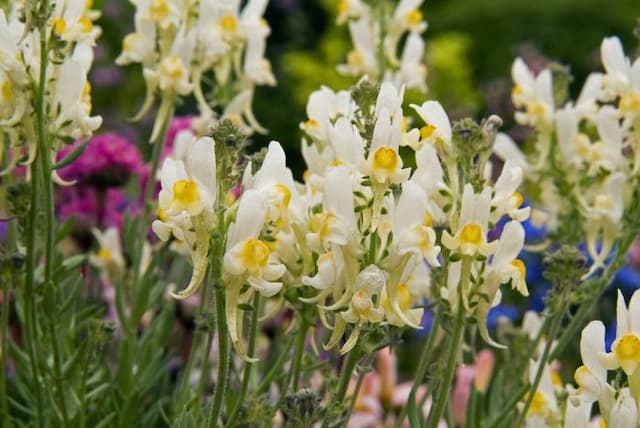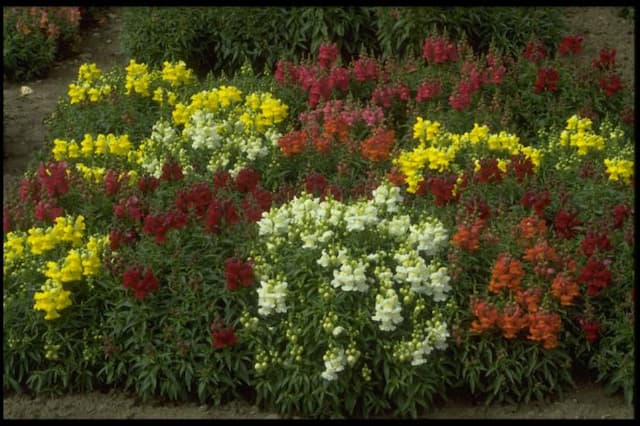Germander speedwell Veronica chamaedrys

ABOUT
Veronica chamaedrys, commonly known as germander speedwell, is a perennial plant that boasts a charming and delicate appearance. It is adorned with small, bright blue flowers which typically have white centers and darker stripes radiating from the center, giving them a striking and distinctive look. The flowers are arranged in loose clusters at the ends of the plant’s stems. These blooms have a shape that resembles a small cup or saucer, adding a gentle touch of beauty to the flora wherever it grows. The leaves of germander speedwell are bright green, and they grow in opposite pairs along the stem. Each leaf is oval to lance-shaped with a coarsely toothed margin, providing a textured appearance to the foliage. A slight hairiness can be observed on the stems and leaves, which gives the plant a soft and slightly fuzzy feeling when touched. The foliage is dense and adds a lush carpet of green to the ground during its growing season, creating a picturesque backdrop for the vivid blue flowers. The stems of germander speedwell are slender and can grow in a creeping fashion, which helps the plant to spread across the ground, hugging the earth in its growth pattern. These graceful stems can give the plant an overall sprawling habit, interweaving gracefully with its surroundings, thereby allowing the little floral gems to pop up amidst the lush greenery. Overall, germander speedwell's appearance exudes a whimsical and enchanting vibe, often evoking the pristine and fairytale-like quality of the meadows and woodlands it commonly inhabits. The combination of its vibrant blue flowers, textured leaves, and soft, creeping stems create a delightful visual harmony in its natural setting.
About this plant
 Names
NamesFamily
Plantaginaceae.
Synonyms
Germander Speedwell, Bird's-eye Speedwell, Cat's Eyes, Eye of the Child Jesus.
Common names
Veronica chamaedrys var. chamaedrys, Veronica chamaedrys var. micans, Veronica micans, Pseudolysimachion chamaedrys.
 Toxicity
ToxicityTo humans
Germander speedwell, commonly known as Veronica chamaedrys, is generally considered non-toxic to humans. There are no well-documented symptoms of poisoning from ingestion of germander speedwell, as it is not known to contain any toxic compounds that would cause harm to humans when touched or ingested in typical quantities found in nature.
To pets
Regarding pets, germander speedwell is also not known to be toxic. Similar to its effects on humans, there are no recognized symptoms of poisoning in pets from the ingestion of germander speedwell. It is not considered harmful to common household pets such as dogs and cats. However, as with any non-food plant, ingestion in large quantities could potentially cause mild gastrointestinal upset due to the unfamiliar material in the diet.
 Characteristics
CharacteristicsLife cycle
Perennials
Foliage type
Deciduous
Color of leaves
Green
Flower color
Blue
Height
1 feet 12 inches [30-60 cm]
Spread
1 feet [30 cm]
Plant type
Herb
Hardiness zones
4
Native area
Europe
Benefits
 General Benefits
General Benefits- Attracts Pollinators: Veronica chamaedrys, also known as Germander Speedwell, is known to attract bees, butterflies, and other beneficial insects, supporting pollination in gardens and natural habitats.
- Aesthetic Appeal: With its bright blue flowers and lush green foliage, Germander Speedwell adds visual interest and natural beauty to gardens and landscapes.
- Ground Cover: It can be used as an effective ground cover due to its mat-forming growth habit, which helps suppress weeds and reduce soil erosion.
- Drought Tolerance: Once established, Germander Speedwell is relatively drought-tolerant, making it suitable for low-water-use gardens and xeriscaping.
- Wildlife Habitat: It provides a habitat for small creatures and beneficial insects, contributing to biodiversity in the garden or ecosystem.
- Low Maintenance: Germander Speedwell is generally low maintenance, requiring minimal care once it is established in an appropriate location.
- Adaptability: This plant can thrive in a range of conditions, from full sun to partial shade, and in various soil types, making it a versatile choice for different garden settings.
 Medical Properties
Medical Properties- Anti-inflammatory: Veronica chamaedrys, also known as Germander Speedwell, has been used traditionally as an herbal remedy for its potential anti-inflammatory effects.
- Astringent: The plant contains tannins that have astringent properties, which can be useful in treating skin irritations and mild wounds.
- Diuretic: Folk medicine attributes diuretic properties to Germander Speedwell, which might aid in the excretion of excess fluids from the body.
- Expectorant: It has been used to promote the clearing of mucus from the airways, potentially providing relief from respiratory conditions.
- Tonic: Traditionally, it has been considered a tonic, with an overall beneficial effect on health and well-being.
 Air-purifying Qualities
Air-purifying QualitiesThis plant is not specifically known for air purifying qualities.
 Other Uses
Other Uses- Germander speedwell can be used as a natural dye, giving a range of colors from green to blue depending on the mordant used.
- The flowers of Germander speedwell may be added to salads or used as a garnish for their delicate appearance and subtle flavor.
- This plant can serve as an indicator species, as it prefers nutrient-rich soils, its presence can reveal soil quality and composition.
- The dried plant, because of its beauty, is often used in floral arrangements or as a component in potpourri mixes.
- Germander speedwell is sometimes planted by beekeepers in the vicinity of hives since it provides an excellent early spring nectar source for bees.
- Gardeners may use Germander speedwell as a natural ground cover due to its spreading habit and tendency to form a dense carpet.
- The flowers have been historically used for sentimental reasons in Victorian times, symbolizing fidelity and representing the phrase "I have not changed."
- Germander speedwell can be utilized in educational settings for botany studies due to its characteristic flower structure and ease of identification.
- Some craft enthusiasts use the small, attractive flowers in pressed flower art, bookmarks, and gift cards for decoration.
- Germander speedwell is sometimes used in companion planting to attract beneficial insects that help to maintain a healthy garden ecosystem.
Interesting Facts
 Feng Shui
Feng ShuiThe plant Veronica chamaedrys, commonly known as Germander Speedwell, is not used in Feng Shui practice.
 Zodiac Sign Compitability
Zodiac Sign CompitabilityThe plant Germander Speedwell is not used in astrology practice.
 Plant Symbolism
Plant Symbolism- Fidelity: Veronica chamaedrys, commonly known as Germander Speedwell, often represents fidelity and loyalty in bouquet symbolism, reflecting the plant's enduring and steadfast nature.
- Clarity: With its bright blue flowers, Germander Speedwell is said to symbolize clarity and the ability to see things clearly, echoing the clear skies its flowers resemble.
- Good Fortune: In folklore, it is believed that Germander Speedwell can bring good luck, especially if a traveler finds it on their path.
 Water
WaterGermander Speedwell prefers evenly moist soil, so it is important to water the plant when the top inch of soil feels dry. Water the plant thoroughly, allowing for water to soak into the soil until it begins to drain freely from the bottom of the pot. Generally, this might equate to watering with approximately one to two gallons every week, but the frequency can vary depending on environmental conditions such as temperature and humidity. Avoid letting the plant sit in waterlogged soil, as this can lead to root rot. Reduce watering in the winter months when the plant's growth slows down.
 Light
LightGermander Speedwell thrives best in full sun to partial shade conditions. It is ideal to place it in a spot where it can receive at least six hours of sunlight daily. However, in regions with very hot summers, providing some afternoon shade will prevent scorching of the leaves. Avoiding deep shade is key, as it can result in leggy plants and fewer flowers.
 Temperature
TemperatureGermander Speedwell is hardy and can tolerate a range of temperatures, typically from 30°F to 85°F. The ideal temperature range for this plant is between 60°F and 70°F which promotes healthy growth. It can survive brief periods of colder or hotter temperatures, but prolonged exposure to extremes can be damaging.
 Pruning
PruningPruning Germander Speedwell is essential to maintain its shape and promote bushier growth. Deadheading spent flowers can encourage a secondary bloom. It is best to prune in late winter or early spring, cutting back the plant by about one-third to encourage new growth. Pruning can be done again lightly after flowering if the plant becomes leggy.
 Cleaning
CleaningAs needed
 Soil
SoilGermander Speedwell thrives in well-drained soil with a pH range of 6.0-7.5; a mix of loam, sand, and compost is ideal to ensure adequate drainage and fertility.
 Repotting
RepottingGermander Speedwell generally does not require frequent repotting; repot young plants annually, mature plants every 2-3 years if they outgrow their containers.
 Humidity & Misting
Humidity & MistingGermander Speedwell prefers moderate humidity levels but is relatively adaptable; it does not require any special humidity considerations.
 Suitable locations
Suitable locationsIndoor
Place Germander Speedwell in bright light, water regularly.
Outdoor
Plant Germander Speedwell in full sun to partial shade and well-drained soil.
Hardiness zone
4-8 USDA
 Life cycle
Life cycleVeronica chamaedrys, commonly known as germander speedwell, begins its life cycle as a seed, which, upon finding suitable moist and partially shaded conditions, germinates in the spring. The seedling develops into a low-growing perennial herb with a rosette of leaves at the base. As it matures, it forms spreading stems that root at the nodes, and lance-shaped leaves with serrated edges appear. Flowering occurs typically in late spring to early summer, producing small, bright blue flowers with white centers and two stamens. After pollination, often by insects, the plant produces tiny heart-shaped capsules containing numerous seeds, completing the cycle. The plant goes dormant in winter and resumes growth with the return of warm weather, living for several years and spreading through both seed dispersal and vegetative reproduction.
 Propogation
PropogationPropogation time
Spring-Early Summer
Propogation: Germander speedwell (Veronica chamaedrys) can be propagated by seed or by division. The most popular method is sowing seeds, which is typically done in spring. To propagate by seed, one should first prepare a well-draining soil mix in a container. Then, the tiny seeds of germander speedwell are sprinkled onto the soil surface, needing light to germinate, so they should not be covered. The container should be kept in a location with indirect sunlight and maintained at a consistent moisture level. Germination usually occurs within two to four weeks, after which seedlings can be carefully transplanted to their final growing positions once they're large enough to handle and after the danger of frost has passed.




![Hebe [Garden Beauty Blue]](/_next/image?url=https%3A%2F%2Fplants-admin.emdemapps.com%2Fimages%2Fplants%2F%2Fimages%2F604b58cbcb4e2.png&w=640&q=75)



